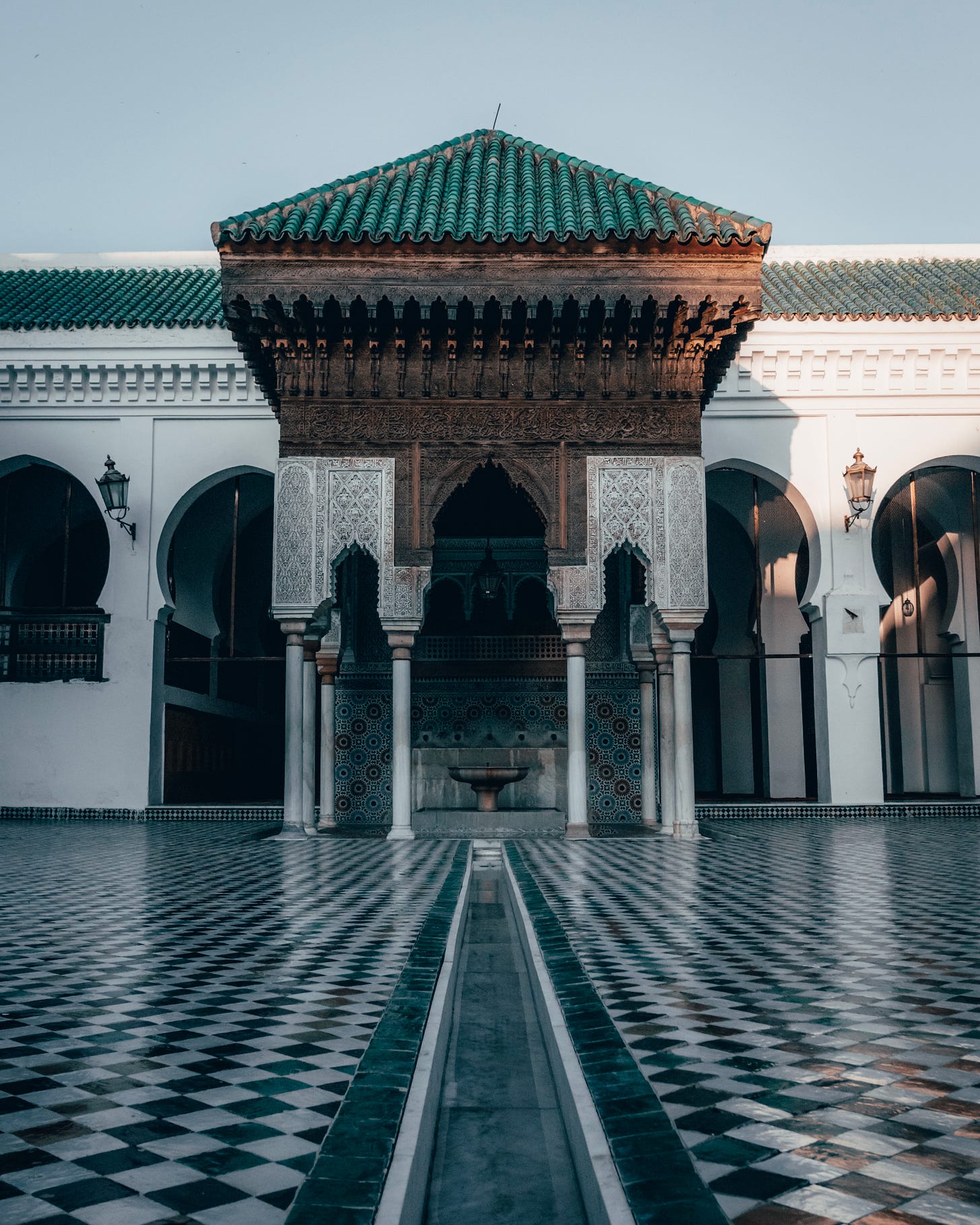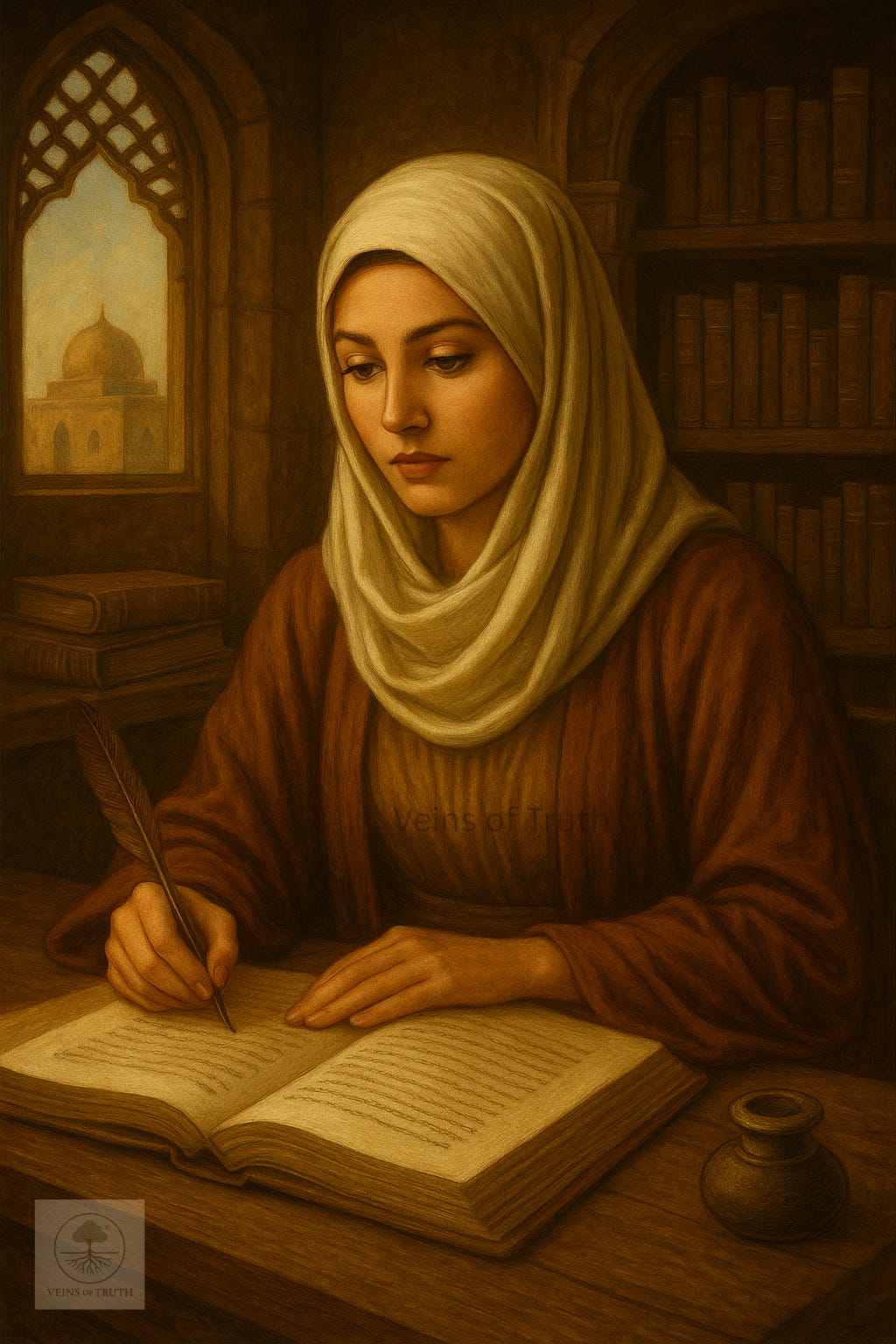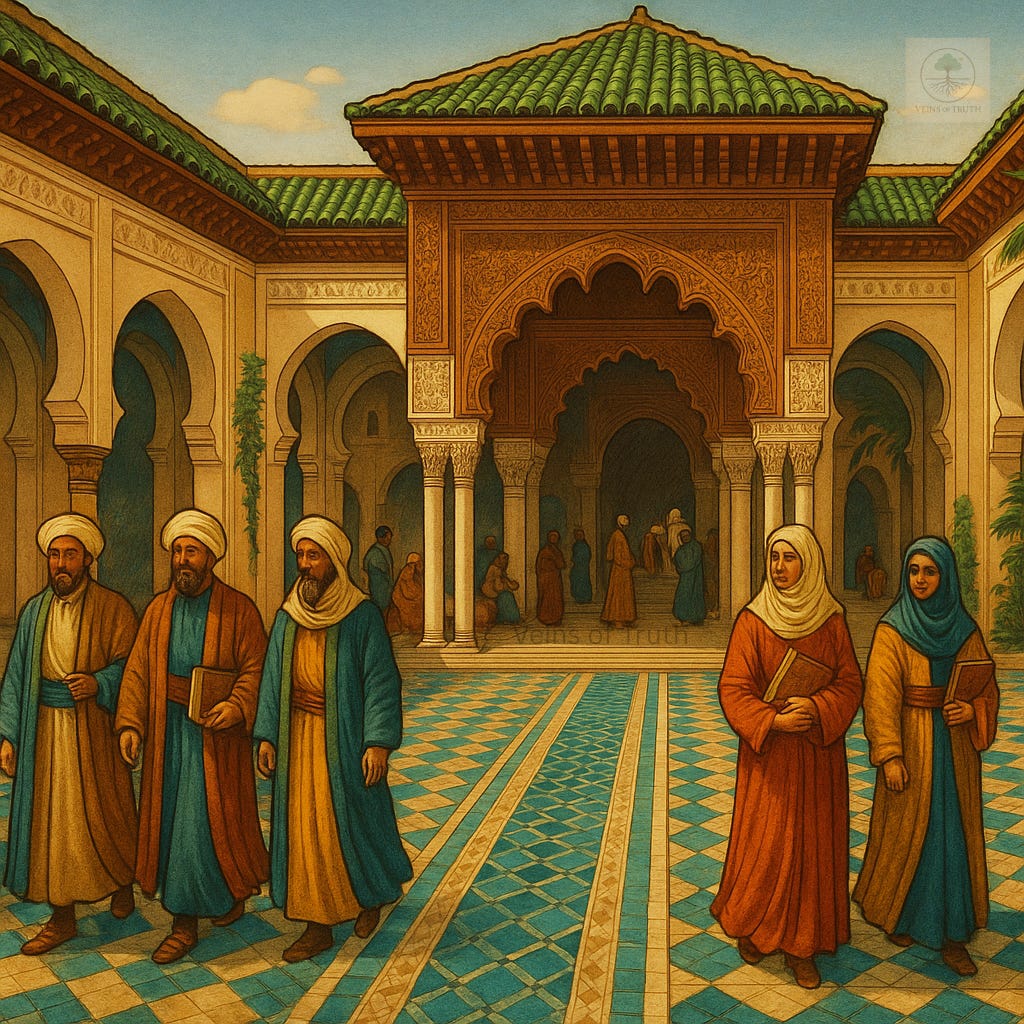You might assume that the first university in the world was Harvard. Or maybe Oxford. Or Cambridge. Yale? The University of London? That’s what most people believe. But the truth is — it was none of those.
The oldest existing, degree-granting university in the world was founded in 859 CE in Fez, Morocco. And it wasn’t established by a Western scholar. The first person to own and build that university was not a man. It was a woman. And not just any woman — a Muslim woman.
Her name was Fatima al-Fihri.
While much of the modern world insists that Muslim women are oppressed, Fatima al-Fihri’s legacy tells a different story. Not only was she free to own property, but she had the power and vision to use that wealth for something eternal: the founding of al-Qarawiyyin University.
In a world where the erasure of Muslim contributions to civilization has become the norm, one name demands to be remembered: Fatima al-Fihri. Not because she was rich. Not because she was powerful. But because she used her wealth, vision, and faith to shape the world in a way that few have—especially as a woman, in a time and place where her influence reached across centuries.
Fatima al-Fihri founded the University of al-Qarawiyyin in 859 CE in Fez, Morocco. It is not a madrasa, not a mosque-school, and not a religious seminary alone. It is the oldest existing and continuously operating degree-granting university in the world, recognized by Guinness World Records. Long before Oxford, Cambridge, or the Sorbonne, the foundations of institutional education were laid down by a Muslim woman.
From Grief to Legacy
Fatima was born in the town of Kairouan (modern-day Tunisia) during the early 9th century. Her family later migrated to Fez, a rapidly growing cultural and religious hub under Idrisid rule. After the death of her husband and father, Fatima inherited considerable wealth. She made a choice that echoes through history: she would use her inheritance to build a mosque and educational institution that would serve her community and generations to come.
She fasted during the entire construction of the university, supervising its development and ensuring its foundations were spiritually grounded. It was not just an act of charity; it was an act of vision, intellect, and trust in Allah. The mosque and university were built with her funds, under her supervision, and in her name—something almost unheard of in her time.
What Made Al-Qarawiyyin a True University?
Al-Qarawiyyin wasn’t just a place for Qur’anic studies. It became a beacon of multidisciplinary scholarship. It offered studies in:
Mathematics
Medicine
Astronomy
Grammar and rhetoric
Logic and philosophy
Law (both Islamic and civic)
Music and even natural sciences
It operated with a structured curriculum, degrees, and certificates issued by qualified scholars. It hosted a vast library, one of the oldest in the world, still standing today. And it attracted legendary scholars, including Ibn Khaldun, Al-Idrisi, Maimonides, and Leo Africanus. It even influenced the European Renaissance through knowledge exchanges in Andalusia.
A Woman Forgotten
Despite all this, how often is her name mentioned in global history books? How many young women today know that the world’s first university was built by someone just like them—a Muslim woman, grieving, faithful, and brave?
Fatima al-Fihri is not a symbol of feminism. She is a symbol of truth. She proves that women were never excluded from Islamic intellectual life. They were its architects. The false narrative that Islam suppresses women collapses under the weight of her story.
She didn’t need recognition. But she deserves remembrance.
A Tale of Two Worlds: Women's Rights Then and There
Fatima al-Fihri’s legacy stands in stark contrast to the rights of women in Europe during the same era. In the 9th century Islamic world, women were granted rights to own, inherit, and manage property independently—a right guaranteed by the Qur’an itself: “For men is a share of what the parents and close relatives leave, and for women is a share of what the parents and close relatives leave, be it little or much—an obligatory share” (Surah An-Nisa, 4:7). This verse was revealed in approximately 625 CE, over 1,400 years ago, during the early Medinan period of the Prophet Muhammad’s mission. At a time when most of the world denied women basic legal status, Islam granted them divinely mandated rights to wealth and financial independence. This verse was revolutionary in its time. In a world where women were largely excluded from inheritance—whether in pre-Islamic Arabia, ancient Greece, Rome, or medieval Europe—Islam was the first to guarantee women a legally protected, divinely ordained share of wealth. But this verse established that women had a divinely ordained, fixed share in inheritance—no matter how large or small the estate. It affirmed women's financial autonomy, allowing them to own, manage, and use their wealth as independent legal persons. This right enabled women like Fatima al-Fihri to not only preserve wealth but to use it for transformative purposes—such as founding the world’s first university. The right to education. The Prophet Muhammad (s.a.w) said, “Seeking knowledge is an obligation upon every Muslim.” (Sunan Ibn Majah 224, Sahih). This command applied to both men and women equally, and Fatima al-Fihri's life is one of the most powerful reflections of that truth.[4] Fatima used this right to inherit her father's wealth and fund the construction of an entire university.
By contrast, in 9th century Christian Europe, most women had no legal identity outside of their fathers or husbands. Under feudal and canon law, women could not independently own property or enter contracts. Even centuries later:
In England, the Married Women’s Property Act was only passed in 1870 and 1882, granting married women the legal right to own and control property.
In France, women could not open a bank account without their husband’s permission until 1965.
In the United States, property rights for married women began to appear state-by-state only in the mid-1800s.
While women in the West were denied the most basic financial autonomy, Fatima al-Fihri was not only managing her own inheritance but using it to lay the foundation for the world’s most enduring educational institution.
This does not mean the Muslim world was a perfect utopia—cultural patriarchy did exist in some regions. But the Islamic legal framework itself gave women rights centuries before the West caught up. Fatima al-Fihri is living proof.
In fact, during the same era, women in Christian Europe had no formal right to education. Schools were limited to male clergy and noblemen, with monasteries and cathedral schools excluding women entirely. A few aristocratic women may have been taught basic literacy at home, but there was no institutional framework for women's education. As historian Joan Ferrante notes, "The ideal woman was pious, obedient, and illiterate."[8]
While the West restricted women’s intellectual growth, Fatima al-Fihri not only had the right to learn, but the authority and resources to build an institution that educated generations of scholars—men and women alike.
The Story Doesn’t End Here
This article is just a doorway. We are writing a full book on the life and legacy of Fatima al-Fihri—the sacrifices she made, the empire she lived under, the architectural and legal marvels of al-Qarawiyyin, and how colonialism nearly buried her name.
Because buried history must be uncovered. And she, above all, deserves her light restored.
For context: If you have any doubts about what came before the university model Fatima al-Fihri introduced, we’ve created a full timeline tracing the evolution of learning — from ancient temple schools and philosophical circles to the first true university.
Not all centers of learning were universities — and this timeline makes that distinction clear. To clarify fact from confusion, we created a complete timeline of global learning institutions — from the earliest temple schools to the rise of formal universities.
Here is the link to that Timeline:
https://www.veinsoftruth.org/p/a-global-timeline-of-learning-institutions
Sources
[1] Guinness World Records. "Oldest existing and continually operating educational institution in the world." https://www.guinnessworldrecords.com/world-records/oldest-university
[2] Bloom, Jonathan, and Sheila Blair. Islamic Arts. Phaidon Press, 1997.
[3] The Qur’an, Surah An-Nisa (4:7).
[4] Holcombe, Lee. Wives and Property: Reform of the Married Women's Property Law in Nineteenth-Century England. University of Toronto Press, 1983.
[5] Bard, Christine. Les femmes dans la société française au XXe siècle. Armand Colin, 2001.
[6] Basch, Norma. In the Eyes of the Law: Women, Marriage, and Property in Nineteenth-Century New York. Cornell University Press, 1982.
[7] Ferrante, Joan M. Woman as Image in Medieval Literature: From the Twelfth Century to Dante. Columbia University Press, 1975.
[8] Nadwi, Mohammad Akram. Al-Muhaddithat: The Women Scholars in Islam. Interface Publications, 2007. Interface Publications, 2007.
[9] Lyons, Jonathan. The House of Wisdom: How the Arabs Transformed Western Civilization. Bloomsbury Press, 2009.
[10] Ibn Abi Zarʿ al-Fasi. Rawḍ al-Qirṭās fī Akhbār al-Maghrib wa Tārīkh Madīnat Fās. 14th century. Originally written in Arabic; cited in modern academic works and Moroccan historical studies as the known source to mention Fatima al-Fihri by name.




